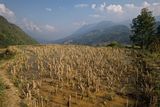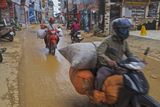Sa Pa NW Vietnam
Vietnam is a multi-ethnic country with many distinct groups. The Vietnamese government recognizes 54 although it is said there may be over 80, each with its own language, lifestyle, and cultural heritage. Most of the ethnic minorities in Vietnam live in the mountainous areas in the north, near the Chinese border in central and northwest Vietnam around the town of Sa Pa. The French called these groups collectively, Montagnards (meaning 'highlanders' or 'mountain people') and both France and the USA used them in their respective wars where the areas experienced heavy fighting. The Hmong (numbering about 1 million people) is one of the largest ethnic groups in Vietnam and can be found around Sa Pa and the Lao Cai province. They originate from South China which they left during the Ming and Qing dynasties about 300 years ago. This departure followed their rebellion against Chinese imperialism at the time.
The images below were taken in Sa Pa and in the villages of the Black Hmong known for their craft, and their traditional clothes made from hemp dyed with a deep indigo blue colour and embroidered with decorations. Today, many Hmong wear Viet or Western clothes due to their broad integration with the Vietnamese community as well as due the influence of foreign visitors. Whilst many of the ethnic groups wear clothes indistinguishable from mainstream Vietnamese, many, mainly women, can be seen wearing the traditional costume. This is particularly useful when selling craftwork to visitors to the region.
Ethnic minorities make up as many as 70 percent of those Vietnamese classified as extremely poor. Increase of tourism in the areas where the ethnic residents live gives an opportunity for very poor inhabitants to earn money. Also, a World Bank study of six ethnic minority communities in Vietnam – San Diu, Muong, Khmer, Xo Dang, Kho Mu and Mong – showed that there are certain factors driving their socio-economic performance and well being. Good connections between where they live and basic infrastructure, and economic clusters, have facilitated the way out of poverty for Muong, San Diu and Khmer groups. Conversely, the visitors affect their traditional ways of life and some children miss school to sell to tourists thus disrupting their future life opportunities. Genuine ethnic guides warn visitors of the effect that their, the visitors', presence can have and ask them to be conscious of this potential influence.
Photographs may be purchased. Please see 'Pricing & Checkout', in the menu to the left.
The images below were taken in Sa Pa and in the villages of the Black Hmong known for their craft, and their traditional clothes made from hemp dyed with a deep indigo blue colour and embroidered with decorations. Today, many Hmong wear Viet or Western clothes due to their broad integration with the Vietnamese community as well as due the influence of foreign visitors. Whilst many of the ethnic groups wear clothes indistinguishable from mainstream Vietnamese, many, mainly women, can be seen wearing the traditional costume. This is particularly useful when selling craftwork to visitors to the region.
Ethnic minorities make up as many as 70 percent of those Vietnamese classified as extremely poor. Increase of tourism in the areas where the ethnic residents live gives an opportunity for very poor inhabitants to earn money. Also, a World Bank study of six ethnic minority communities in Vietnam – San Diu, Muong, Khmer, Xo Dang, Kho Mu and Mong – showed that there are certain factors driving their socio-economic performance and well being. Good connections between where they live and basic infrastructure, and economic clusters, have facilitated the way out of poverty for Muong, San Diu and Khmer groups. Conversely, the visitors affect their traditional ways of life and some children miss school to sell to tourists thus disrupting their future life opportunities. Genuine ethnic guides warn visitors of the effect that their, the visitors', presence can have and ask them to be conscious of this potential influence.
Photographs may be purchased. Please see 'Pricing & Checkout', in the menu to the left.

SESAP 030 Clothes shop, Sa Pa, Vietnam

SESAP 015 An 'indigo' village Tan Van, northern Vietnam

SESAP 001 Mhong women in traditional dress, N Vietnam

SESAP 005 Rice field in the northern mountains, Vietnam

SESAP 006 In the N Vietnamese mountains

SESAP 010 Roadside butcher on the Lao Chai

SESAP 007 Muong Hoa valley, NW Vietnam

SESAP 008 'Messaging' along the Lao Chai, towards Ta Van North Vietnam

SESAP 009 along the Lao Chai, towards Ta Van, NW Vietnam

SESAP 003 Rice fields on the border with China, N Vietnam

SESAP 004 Rice fields on the border with China, N Vietnam

SESAP 011 Transporting logs on the Lao Chai, NW Vietnam

SESAP 012 Indigo dyed cloth out to dry, northern Vietnam

SESAP 013 Indigo dyed cloth out to dry, northern Vietnam.

SESAP 014 Along the Lao Chai, towards Ta Van, NW Vietnam

SESAP 002 Mhong women in traditional dress, N Vietnam

SESAP 031 On the street, Sa Pa, Vietnam

SESAP 016 Moto's on the Lao Chai, NW Vietnam

SESAP 033 La Vie, Sa Pa, north Vietnam

SESAP 017 Wedding preparations, Ta Van, NW Vietnam

SESAP 018 Online games, Ta Van, NW Vietnam.

SESAP 019 Construction work, Ta Van, NW Vietnam

SESAP 021 Front door Ta Van, NW Vietnam

SESAP 032 Hardware store, Sa Pa, Vietnam

SESAP 022 Rce growing terraces, northern mountains, Vietnam

SESAP 027 Washing clothes, down stream of Cau May, NW Vietnam

SESAP 023 Rice field in the northern mountains, Vietnam

SESAP 028 River crossing down stream of Cau May, NW Vietnam

SESAP 024 Rce growing terraces, northern mountains, Vietnam

SESAP 029 Digger, Sa Pa, north Vietnam

SESAP 025 Rce growing terraces, northern mountains, Vietnam

SESAP 026 Rce growing terraces, northern mountains, Vietnam

SESAP 034 Fruit Vendor, Sa Pa, Vietnam

SESAP 035 Massage Parlour, Sa Pa, Vietnam

SESAP 036 Clearing up, Sa Pa, north Vietnam

SESAP 037 'Hot Cakes" Sa Pa, north Vietnam

SESAP 038 Wedding photographer, Sa Pa, Vietnam

SESAP 039 Wedding photographs, Sa Pa, Vietnam

SESAP 040 Building work, Sa Pa, Vietnam

SESAP 041 Parking attendant, nr Sa Pa, Vietnam

SESAP 042 Looking towards the Vietnam China border

SESAP 043 Workers Temporary Accommodation, Sa Pa, Vietnam

SESAP 044 Plastic Enclosure, Ta Van, NW Vietnam, Vietnam

SESAP 045 On the move, Sa Pa, Vietnam

